airbag OPEL CORSA F 2020 Manual user
[x] Cancel search | Manufacturer: OPEL, Model Year: 2020, Model line: CORSA F, Model: OPEL CORSA F 2020Pages: 229, PDF Size: 21.14 MB
Page 43 of 229
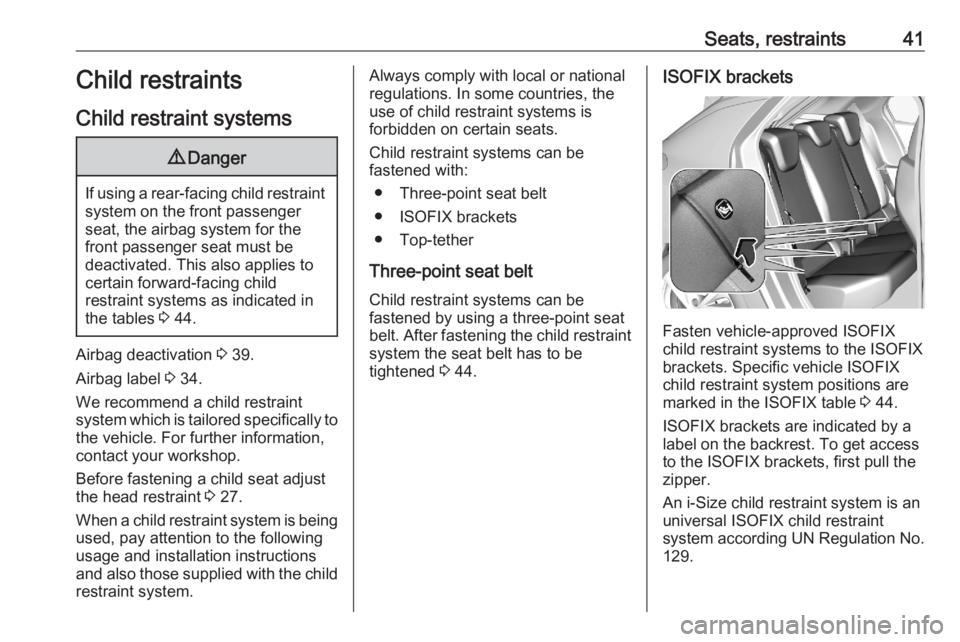
Seats, restraints41Child restraints
Child restraint systems9 Danger
If using a rear-facing child restraint
system on the front passenger
seat, the airbag system for the
front passenger seat must be
deactivated. This also applies to certain forward-facing child
restraint systems as indicated in
the tables 3 44.
Airbag deactivation 3 39.
Airbag label 3 34.
We recommend a child restraint system which is tailored specifically to the vehicle. For further information,
contact your workshop.
Before fastening a child seat adjust
the head restraint 3 27.
When a child restraint system is being
used, pay attention to the following
usage and installation instructions and also those supplied with the child restraint system.
Always comply with local or national
regulations. In some countries, the
use of child restraint systems is
forbidden on certain seats.
Child restraint systems can be
fastened with:
● Three-point seat belt
● ISOFIX brackets
● Top-tether
Three-point seat belt
Child restraint systems can be
fastened by using a three-point seat
belt. After fastening the child restraint system the seat belt has to be
tightened 3 44.ISOFIX brackets
Fasten vehicle-approved ISOFIX
child restraint systems to the ISOFIX
brackets. Specific vehicle ISOFIX
child restraint system positions are
marked in the ISOFIX table 3 44.
ISOFIX brackets are indicated by a
label on the backrest. To get access
to the ISOFIX brackets, first pull the
zipper.
An i-Size child restraint system is an
universal ISOFIX child restraint
system according UN Regulation No.
129.
Page 46 of 229
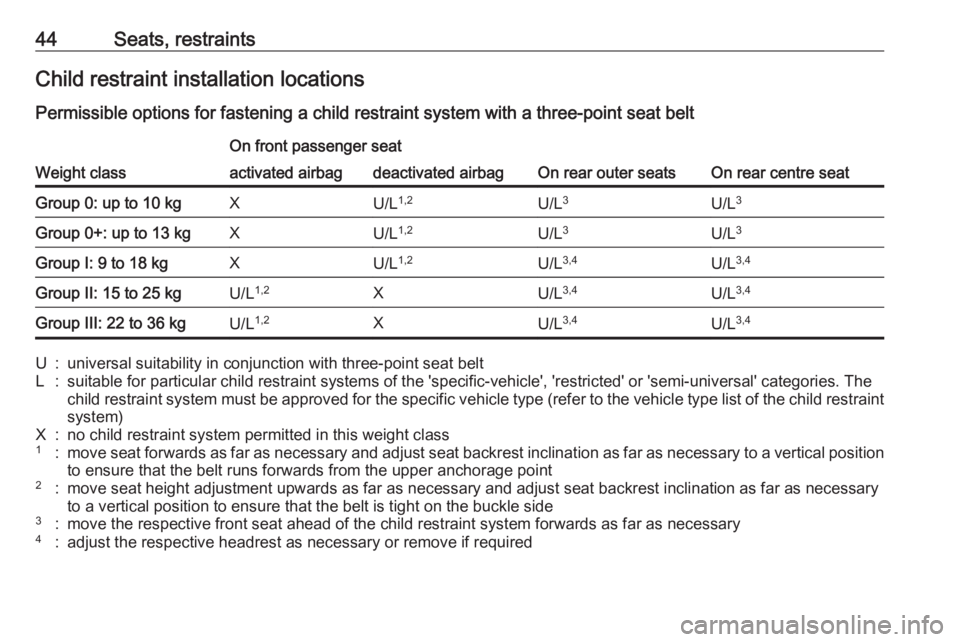
44Seats, restraintsChild restraint installation locations
Permissible options for fastening a child restraint system with a three-point seat belt
Weight class
On front passenger seat
On rear outer seatsOn rear centre seat
activated airbagdeactivated airbagGroup 0: up to 10 kgXU/L 1,2U/L 3U/L3Group 0+: up to 13 kgXU/L1,2U/L3U/L 3Group I: 9 to 18 kgXU/L1,2U/L3,4U/L 3,4Group II: 15 to 25 kgU/L1,2XU/L 3,4U/L3,4Group III: 22 to 36 kgU/L1,2XU/L3,4U/L3,4U:universal suitability in conjunction with three-point seat beltL:suitable for particular child restraint systems of the 'specific-vehicle', 'restricted' or 'semi-universal' categories. The
child restraint system must be approved for the specific vehicle type (refer to the vehicle type list of the child restraint
system)X:no child restraint system permitted in this weight class1:move seat forwards as far as necessary and adjust seat backrest inclination as far as necessary to a vertical position to ensure that the belt runs forwards from the upper anchorage point2:move seat height adjustment upwards as far as necessary and adjust seat backrest inclination as far as necessaryto a vertical position to ensure that the belt is tight on the buckle side3:move the respective front seat ahead of the child restraint system forwards as far as necessary4:adjust the respective headrest as necessary or remove if required
Page 47 of 229
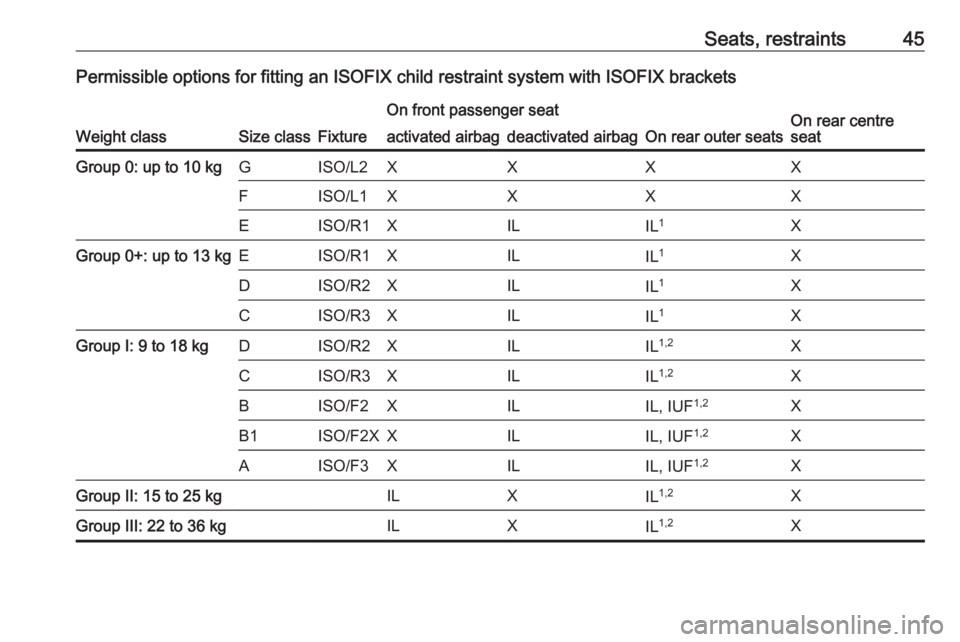
Seats, restraints45Permissible options for fitting an ISOFIX child restraint system with ISOFIX brackets
Weight classSize classFixture
On front passenger seat
On rear outer seatsOn rear centre
seatactivated airbagdeactivated airbagGroup 0: up to 10 kgGISO/L2XXXXFISO/L1XXXXEISO/R1XILIL 1XGroup 0+: up to 13 kgEISO/R1XILIL 1XDISO/R2XILIL1XCISO/R3XILIL1XGroup I: 9 to 18 kgDISO/R2XILIL1,2XCISO/R3XILIL1,2XBISO/F2XILIL, IUF 1,2XB1ISO/F2XXILIL, IUF1,2XAISO/F3XILIL, IUF 1,2XGroup II: 15 to 25 kgILXIL1,2XGroup III: 22 to 36 kgILXIL1,2X
Page 48 of 229
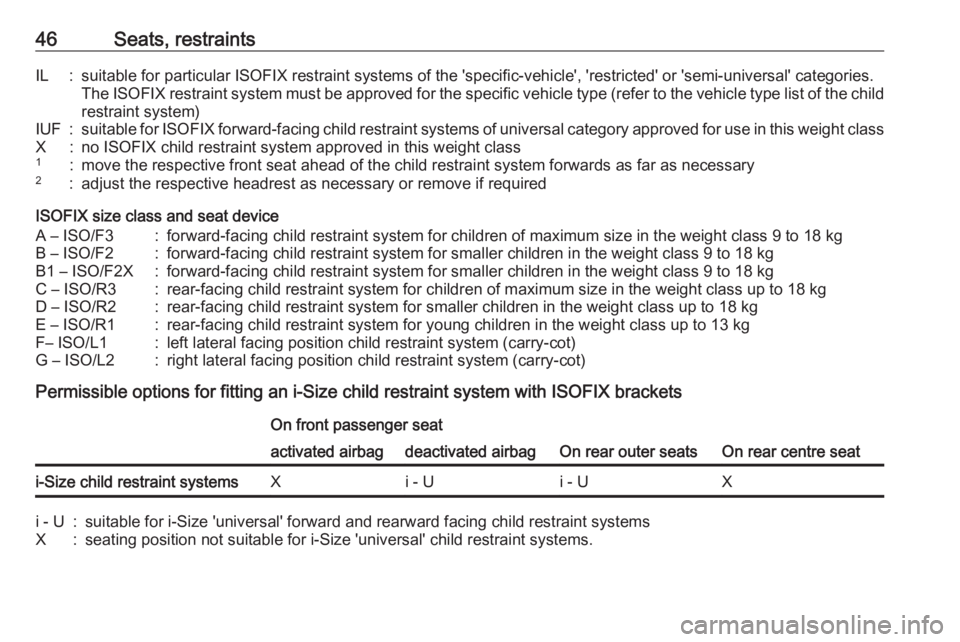
46Seats, restraintsIL:suitable for particular ISOFIX restraint systems of the 'specific-vehicle', 'restricted' or 'semi-universal' categories.
The ISOFIX restraint system must be approved for the specific vehicle type (refer to the vehicle type list of the child restraint system)IUF:suitable for ISOFIX forward-facing child restraint systems of universal category approved for use in this weight classX:no ISOFIX child restraint system approved in this weight class1:move the respective front seat ahead of the child restraint system forwards as far as necessary2:adjust the respective headrest as necessary or remove if required
ISOFIX size class and seat device
A – ISO/F3:forward-facing child restraint system for children of maximum size in the weight class 9 to 18 kgB – ISO/F2:forward-facing child restraint system for smaller children in the weight class 9 to 18 kgB1 – ISO/F2X:forward-facing child restraint system for smaller children in the weight class 9 to 18 kgC – ISO/R3:rear-facing child restraint system for children of maximum size in the weight class up to 18 kgD – ISO/R2:rear-facing child restraint system for smaller children in the weight class up to 18 kgE – ISO/R1:rear-facing child restraint system for young children in the weight class up to 13 kgF– ISO/L1:left lateral facing position child restraint system (carry-cot)G – ISO/L2:right lateral facing position child restraint system (carry-cot)
Permissible options for fitting an i-Size child restraint system with ISOFIX brackets
On front passenger seat
On rear outer seatsOn rear centre seat
activated airbagdeactivated airbagi-Size child restraint systemsXi - Ui - UXi - U:suitable for i-Size 'universal' forward and rearward facing child restraint systemsX:seating position not suitable for i-Size 'universal' child restraint systems.
Page 56 of 229
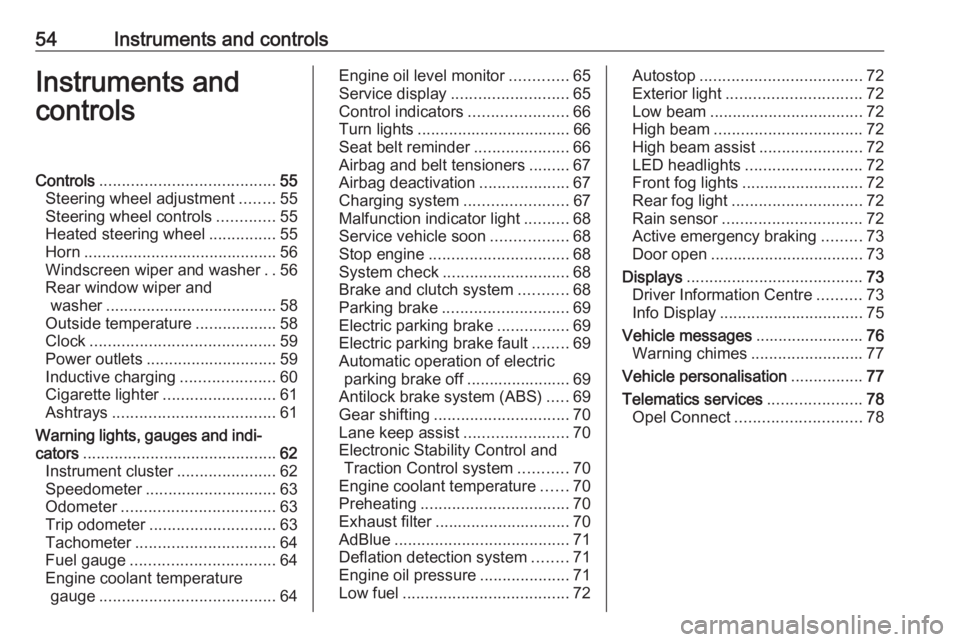
54Instruments and controlsInstruments and
controlsControls ....................................... 55
Steering wheel adjustment ........55
Steering wheel controls .............55
Heated steering wheel ...............55
Horn ........................................... 56
Windscreen wiper and washer ..56
Rear window wiper and washer ...................................... 58
Outside temperature ..................58
Clock ......................................... 59
Power outlets ............................. 59
Inductive charging .....................60
Cigarette lighter ......................... 61
Ashtrays .................................... 61
Warning lights, gauges and indi‐ cators ........................................... 62
Instrument cluster ......................62
Speedometer ............................. 63
Odometer .................................. 63
Trip odometer ............................ 63
Tachometer ............................... 64
Fuel gauge ................................ 64
Engine coolant temperature gauge ....................................... 64Engine oil level monitor.............65
Service display .......................... 65
Control indicators ......................66
Turn lights .................................. 66
Seat belt reminder .....................66
Airbag and belt tensioners .........67
Airbag deactivation ....................67
Charging system .......................67
Malfunction indicator light ..........68
Service vehicle soon .................68
Stop engine ............................... 68
System check ............................ 68
Brake and clutch system ...........68
Parking brake ............................ 69
Electric parking brake ................69
Electric parking brake fault ........69
Automatic operation of electric parking brake off ....................... 69
Antilock brake system (ABS) .....69
Gear shifting .............................. 70
Lane keep assist .......................70
Electronic Stability Control and Traction Control system ...........70
Engine coolant temperature ......70
Preheating ................................. 70
Exhaust filter .............................. 70
AdBlue ....................................... 71
Deflation detection system ........71
Engine oil pressure ....................71
Low fuel ..................................... 72Autostop.................................... 72
Exterior light .............................. 72
Low beam .................................. 72
High beam ................................. 72
High beam assist .......................72
LED headlights .......................... 72
Front fog lights ........................... 72
Rear fog light ............................. 72
Rain sensor ............................... 72
Active emergency braking .........73
Door open .................................. 73
Displays ....................................... 73
Driver Information Centre ..........73
Info Display ................................ 75
Vehicle messages ........................76
Warning chimes .........................77
Vehicle personalisation ................77
Telematics services .....................78
Opel Connect ............................ 78
Page 64 of 229
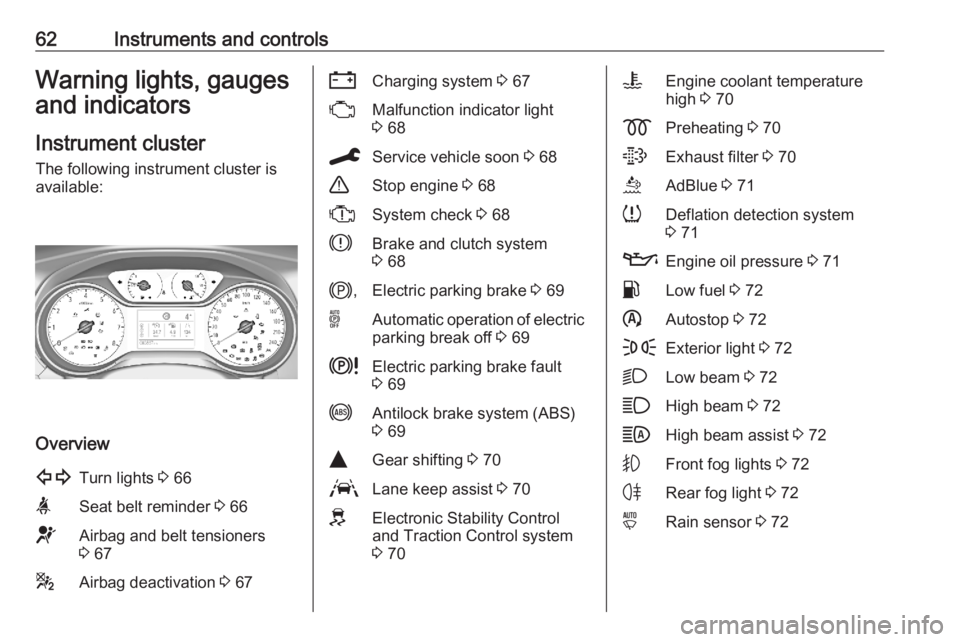
62Instruments and controlsWarning lights, gauges
and indicators
Instrument cluster
The following instrument cluster is
available:
Overview
1Turn lights 3 66aSeat belt reminder 3 66dAirbag and belt tensioners
3 67gAirbag deactivation 3 67SCharging system 3 67WMalfunction indicator light
3 68CService vehicle soon 3 68+Stop engine 3 68XSystem check 3 68hBrake and clutch system
3 68j ,Electric parking brake 3 69oAutomatic operation of electric
parking break off 3 69kElectric parking brake fault
3 69iAntilock brake system (ABS)
3 69YGear shifting 3 70LLane keep assist 3 70JElectronic Stability Control
and Traction Control system
3 70VEngine coolant temperature
high 3 70zPreheating 3 70tExhaust filter 3 70uAdBlue 3 71qDeflation detection system
3 71TEngine oil pressure 3 71rLow fuel 3 72nAutostop 3 72FExterior light 3 72DLow beam 3 72AHigh beam 3 72BHigh beam assist 3 72GFront fog lights 3 72HRear fog light 3 72yRain sensor 3 72
Page 69 of 229
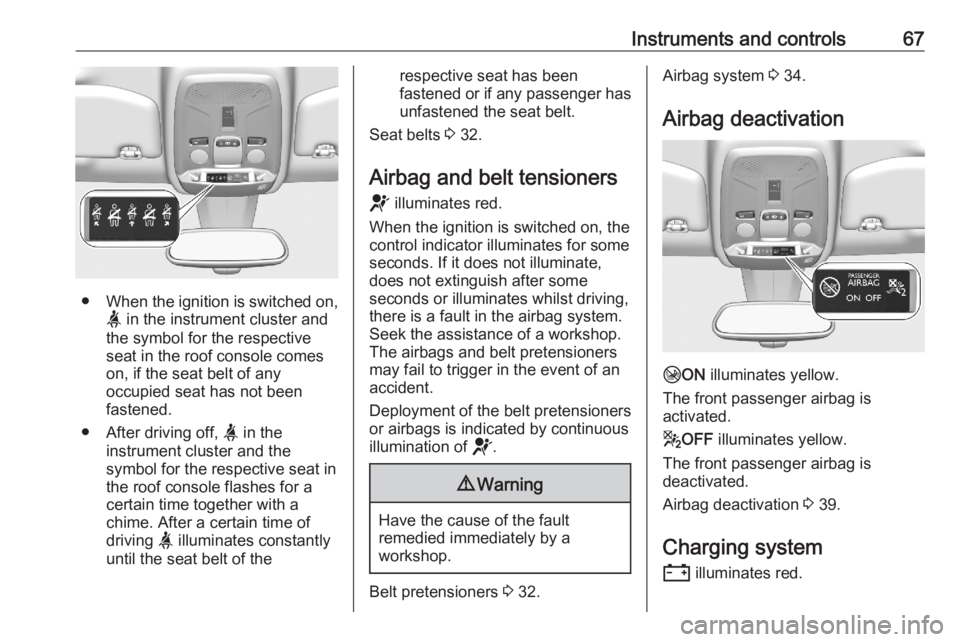
Instruments and controls67
●When the ignition is switched on,
a in the instrument cluster and
the symbol for the respective
seat in the roof console comes
on, if the seat belt of any
occupied seat has not been
fastened.
● After driving off, a in the
instrument cluster and the
symbol for the respective seat in
the roof console flashes for a
certain time together with a
chime. After a certain time of
driving a illuminates constantly
until the seat belt of the
respective seat has been
fastened or if any passenger has
unfastened the seat belt.
Seat belts 3 32.
Airbag and belt tensioners d illuminates red.
When the ignition is switched on, the
control indicator illuminates for some
seconds. If it does not illuminate,
does not extinguish after some
seconds or illuminates whilst driving,
there is a fault in the airbag system.
Seek the assistance of a workshop.
The airbags and belt pretensioners
may fail to trigger in the event of an
accident.
Deployment of the belt pretensioners
or airbags is indicated by continuous
illumination of d.9Warning
Have the cause of the fault
remedied immediately by a
workshop.
Belt pretensioners 3 32.
Airbag system 3 34.
Airbag deactivation
H ON illuminates yellow.
The front passenger airbag is
activated.
g OFF illuminates yellow.
The front passenger airbag is
deactivated.
Airbag deactivation 3 39.
Charging system
S illuminates red.
Page 81 of 229

Instruments and controls79Emergency call function and
breakdown call function are operated
by the buttons in the overhead
console.
Status LED in the overhead
console
Illuminates green and red and
extinguishes after a short time, when the ignition is switched on: the system
works properly.
Illuminates red: fault in the system.
Contact a workshop.
Flashes red: backup battery needs
replacement. Contact a workshop.
Emergency call The emergency call function will
establish a connection to the nearest
public safety answering point (PSAP).
A minimum set of data including
vehicle and location information will
be sent to the PSAP.Note
Establishing an emergency call may
not be possible in areas without
sufficient network availability or due
to hardware damage during an
accident.
In case of an emergency, press the
red SOS button for more than
2 seconds . The LED flashes green to
confirm that a connection to the nearest PSAP is being established.
The LED illuminates steadily as long
as the call is active.
Pressing the SOS button immediately
a second time will terminate the call.
The LED switches off.
Automatic crash notification
In case of an accident with airbag
deployment, an automatic
emergency call is established and an automatic crash notification will be
transmitted to the next PSAP.
Breakdown call Pressing the . button for more than
2 seconds connects you to a roadside assistance service provider.For information about coverage and
scope of services of the roadside
assistance, please refer to the
Service and warranty booklet.
Privacy settings
Privacy settings of Opel Connect can
be configured in your vehicle. This will
impact the set of data being sent, e.g.,
in case a breakdown call is
triggered.The emergency call
function will not be impacted.
Depending on version, the privacy
settings can be changed by
simultaneously pressing . and
SOS in the overhead console or via
the system settings menu in the Info Display.
Page 89 of 229

Lighting87Interior lighting
Instrument panel
illumination control
Brightness of the following lights can
be adjusted when the exterior lights
are on:
● instrument panel illumination
● Info Display
● illuminated switches and operation elements
Turn thumb wheel F and hold until
the desired brightness is obtained.
Interior lights
During entry and exit of the vehicle,
the front and rear courtesy lights
automatically switch on and then off
after a delay.
Note
In the event of an accident with
airbag deployment the courtesy
lights are turned on automatically.
Front courtesy light
Operate rocker switch:
;:automatic switching on
and offpress §:onpress 2:offReading lights
Operated by pressing z.
Sunvisor lights Illuminates when the cover is opened.
Page 104 of 229
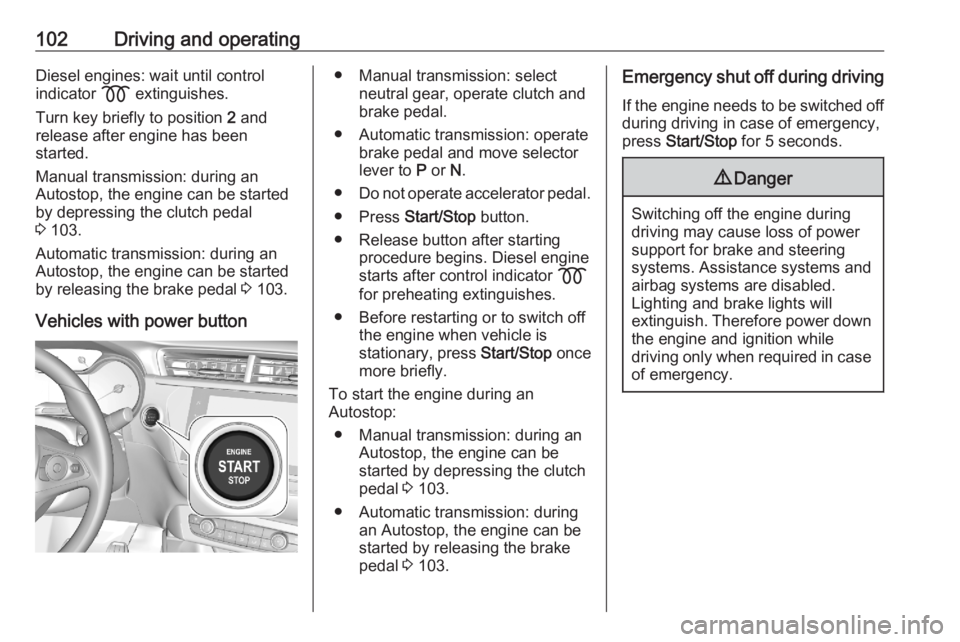
102Driving and operatingDiesel engines: wait until control
indicator z extinguishes.
Turn key briefly to position 2 and
release after engine has been
started.
Manual transmission: during an
Autostop, the engine can be started
by depressing the clutch pedal
3 103.
Automatic transmission: during an
Autostop, the engine can be started
by releasing the brake pedal 3 103.
Vehicles with power button● Manual transmission: select neutral gear, operate clutch and
brake pedal.
● Automatic transmission: operate brake pedal and move selector
lever to P or N.
● Do not operate accelerator pedal.
● Press Start/Stop button.
● Release button after starting procedure begins. Diesel engine
starts after control indicator z
for preheating extinguishes.
● Before restarting or to switch off the engine when vehicle is
stationary, press Start/Stop once
more briefly.
To start the engine during an
Autostop:
● Manual transmission: during an Autostop, the engine can be
started by depressing the clutch
pedal 3 103.
● Automatic transmission: during an Autostop, the engine can be
started by releasing the brake pedal 3 103.Emergency shut off during driving
If the engine needs to be switched offduring driving in case of emergency,
press Start/Stop for 5 seconds.9Danger
Switching off the engine during
driving may cause loss of power
support for brake and steering
systems. Assistance systems and
airbag systems are disabled.
Lighting and brake lights will
extinguish. Therefore power down the engine and ignition while
driving only when required in case of emergency.